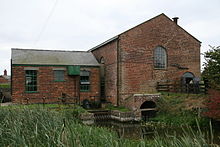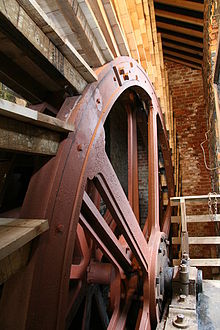- Dogdyke Engine
-
The Dogdyke Engine is a drainage engine near Tattershall, Lincolnshire, in England. 2,500 acres (1,012 ha) of land around Tattershall was authorised for drainage in 1796, and came under the control of the Witham Third District commissioners in 1844[1]
The building dates to 1856 when a rotative beam engine was built to replace windmill style engines possibly dating to 1540 and draining land between the rivers Bain and Witham.[2] The engine discharged into the River Witham,[3] but has a long fetch from a drain parallel to the river called The Dogdyke engine drain originating just south of Kirkstead at a place called Parkbeck.[4]
1856 is relatively late and Wheeler does say that the 1856 engine replaces one installed in 1841,[1] but the location of that is unknown.
The building is a grade II listed ancient monument.[5]
Contents
Engines
- Bradley and Craven Beam engine and scoop wheel, built 1856
- Ruston & Hornsby Diesel engine and centrifugal pump, built 1940
- Ruston & Hornsby auxiliary engine.
Steam engine
The steam engine is maintained by a preservation trust, and steamed on weekends throughout the summer.[6] Although the Pinchbeck Engine is older, it can no longer be steamed. The preservation trust claim this is the oldest working steam drainage engine.[6]
The engine built by Bradley & Craven of Wakefield has a 16 foot (4.9 m) flywheel, and a cylinder of 24 inches (0.61 m) diameter and 48 inches (1.2 m) stroke. [3] The construction is similar to an 'A' frame, but the decorative form of the cast iron upright obscures that basic shape and might be considered unique.
The scoop wheel is 24 feet (7.3 m) in diameter and runs at up to 7rpm through a 4:1 gearbox from the engine.[3]
The first boiler, which lasted until 1909, was a twin tube Cornish type, at 12psi. The replacement was a Foster locomotive-style tubed boiler delivering 15psi. Although the structure of this boiler survives, a modern vertical boiler is used for the demonstration steamings.[3]
The original 100 feet (30 m) Chimney was struck by lightning in 1922 and reduced somewhat. It was felled in 1941 after the conversion to diesel operation.[3]
Diesel engines
The two diesel engines are maintained by The Witham Third District Internal Drainage Board as a standby for the nearby electric pumping station. They are usually operated when the museum is open.[6]
The steam engine was replaced in 1940 by a Ruston & Hornsby 7XHR diesel engine, serial number 194833, driving a 22 inch Gwynnes centrifugal pump.[3] This engine has a capacity of 23.6 litre.[6] The 7XHR design has a single horizontal cylinder of 10 inches (25.4 cm) bore, 18.5 inches (47.0 cm) stroke, and develops 40 horsepower (30 kW) at 300rpm.[7]
There is also a Ruston & Hornsby 1VTO auxiliary engine, used to provide the starting air for the larger engine and to operate a small priming pump for the Gwynnes pump.[6] The 1VTO design has a single horizontal cylinder of 4 inches (10.2 cm) bore, 4 inches (10.2 cm) stroke, and develops 5 horsepower (4 kW) at 1000rpm.[7]
Public access
Access to the site on steaming days involves driving down an unmade road and walking across a grassed area. Although essentially on one level, disabled access is limited because of the historic nature of the site.[6]
Toilets, teas and limited wheelchair access are offered.[8]
See also
References
- ^ a b Wheeler M.inst.C.E, W.H. (1868). History of the Fens of South Lincolnshire (1 ed.). Newcombe, Boston.
- ^ "National monument record". http://www.pastscape.org.uk/hob.aspx?hob_id=352674.
- ^ a b c d e f Hinde, K.S.G. (2006). Fenland Pumping Engines. Landmark. p. 175. ISBN 1-84306-188-0.
- ^ "IDB map showing start of engine drain". http://www.witham-3rd-idb.gov.uk/eMaps/mapper.php?scale=3&scale3map=558.
- ^ "Details of ancient monument listing no. 264". http://britishlistedbuildings.co.uk/en-400460-dogdyke-pumping-station-tattershall.
- ^ a b c d e f "The preservation trust web site". http://www.dogdyke.com/.
- ^ a b "Table of Ruston & Hornsby Diesel engine parameters on enthusiasts web site". http://realdiesels.co.uk/rustondata.html.
- ^ "Summary tourist information". http://www.lincsheritageforum.org.uk/museum/dogdyke-pumping-station.
External links
Video Links
Categories:- Museums in Lincolnshire
- Preserved beam engines
- Preserved stationary steam engines
- Beam engines
- Buildings and structures in Lincolnshire
- Drainage
- Grade II listed buildings in Lincolnshire
- Scheduled Ancient Monuments in Lincolnshire
- Steam museums in the United Kingdom
- Buildings and structures completed in 1856
Wikimedia Foundation. 2010.




